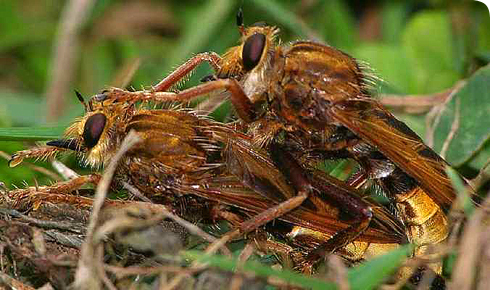Biology
The adult hornet robber fly has a body length of 19-28mm and a wing length of 15-18mm. The life expectancy of Asilus crabroniformis is 2-3 years.
Lifecycle
The adult females lays her eggs in, on, around or underneath drying friable soil mixed with livestock dung or just the surface-dry dung of cows, horses and rabbits.
The larvae are associated with surface-dry dung, with only cattle and rabbit dung being chosen (Pinchen et al 1998).The eggs are laid in or beneath this dung . The larvae are thought to be free-living within the soil although the current research is limited
They take approximately 2 years to develop and are thought to feed on dung beetle larvae and other dung and soil-bourne invertebrates. There does appear to be an association with dung beetle larvae, with among others, a report of having found one within of a cluster of larval cells of Geotropes beetles.
The larval stage can last as long as 2-3 years. Pupation has been observed with the larvae forming their own burrow with pupation occurring within smooth lined cells, with adults emerging approximately 1 month later.
The adults emerge from mid-June with the peak being July and adults being seen to late October. Adults fly from late June to Late October when temperatures are about 16oC.
Toolbox
Follow the Curator of Diptera's blog

What happens behind the scenes in the Museum's Life Sciences Department? Curator Erica McAlister has about 30,000 species of fly to look after, and fieldwork trips at home and abroad. Her life is never dull!
Follow the blog